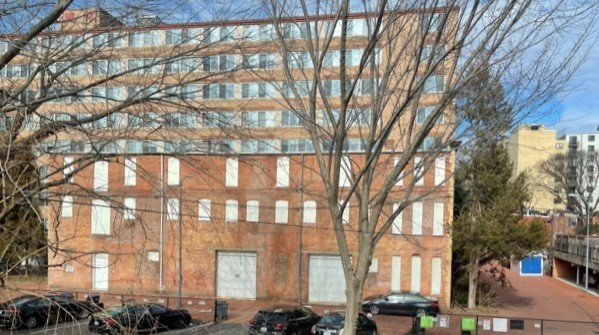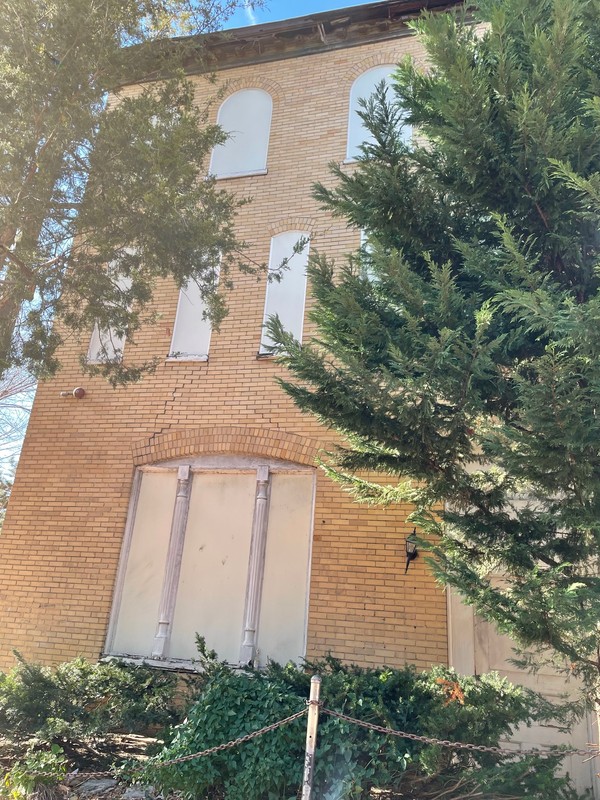Nash's Livery Stable
Introduction
Text-to-speech Audio
Built in 1914, Wilber Nash's large brick commercial livery stable rented horses and carriages to the community. It is one of the few remaining livery stables in D.C.'s alleys, and the only one in Foggy Bottom. By 1914, the automobile was becoming more popular, reducing the need for stables. The building has functioned as a warehouse since at least the 1940s. It is a protected historic building and has the potential for future adaptive re-use.
Images
Nash's Stable showing carriage entrances, with the 925 Apartments looming in the background

The Stable's office entry door and (boarded-up) windows with decorative trim

Detail of the damaged roofline trim and brick window arches above the office entry to Nash's Stable
.jpg)
The metal hook at the roofline was used to bring hay to the top floor
.jpg)
Snows Court in 1913 - Nash's stable was later built on Lot 63 (The red structures are brick and the yellow are wood-frame.)
.jpg)
Backstory and Context
Text-to-speech Audio
The large three story building is Wilber F. Nash’s livery stable (920 Snows Court). Nash’s stable is one of eight remaining commercial livery stables in Washington's alleys. During the 1870s to the 1910s, there were typically 40-70 livery stables in the City. Such stables rented out horses and carriages and sometimes also bought and sold or boarded horses. Customers could rent horses and carriages for business, funerals, weddings, or just rides in the city and its parks.
Wilber Nash was a prominent merchant and builder in Washington, and his projects included work on the White House stable in 1916. He died at age 92, in 1951, leaving an estate of $1.2M. The stable's architect was Thomas M. Medford. He was a prolific Washington architect and engineer who served both the District and federal Governments for 18 years. Medford designed a variety of commercial and residential buildings in D.C.
By the time Nash's Stable was constructed in 1914, automobiles had begun to replace horses-drawn vehicles. The stable however was used to house working dray horses or horses from nearby riding stables.
In Nash's stable, the horses were taken up a ramp to the second level (as indicated by the horse stall windows). The carriages were housed on the first level and hay on the top level. The top-level windows were also used for ventilation. The stable's office door is on the narrow side of the building, facing the alley. The office side features intricate wood trim pieces around the windows, door and roofline. Inside, the lower level ceiling has stamped metal ceiling tiles with a "square in square" pattern and decorative metal crown molding.
By the 1940s, the stable was primarily used as a warehouse. It also housed an illegal all-hours crap game, until new apartments blocked the view of approaching police. In 1959, Marshall Coyne, the developer of Washington's Madison Hotel, bought the property and built the 925 (25th St.) Apartments. The company that owns the 925 building continues to use the stable for storage and the same company owns the short term Zip Car rental parking lot.
Cite This Entry
FBA History Project, . "Nash's Livery Stable." Clio: Your Guide to History. December 1, 2022. Accessed March 31, 2025. https://theclio.com/tour/2098/5
Sources
Kim Prothro Williams, The DC Historic Alley Buildings Survey, 2014 (see link below)
D.C. Property Records, 920 Snows Ct.
"Snows Court Tradition Imperiled," Foggy Bottom News, Jan. 1959
Mary E. Healy, "I remember...Foggy Bottom, Foggy Bottom News, Apr. 1981
"Nash leaves $1,280,000 to children," The Evening Star, Aug. 24, 1951 at p. 6
Collins, Herbert R., "The White House Stables and Garages," Records of the Columbia Historical Society, Vol. 63/65, pp. 366-385
Leone/Vogt, 2021
Vogt/Leone, 2021
Vogt/Leone, 2021
Leone/Vogt, 2021
Baist Real Estate Map, 1913, Library of Congress

